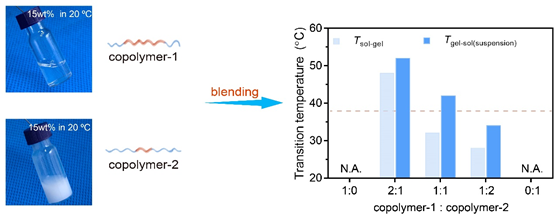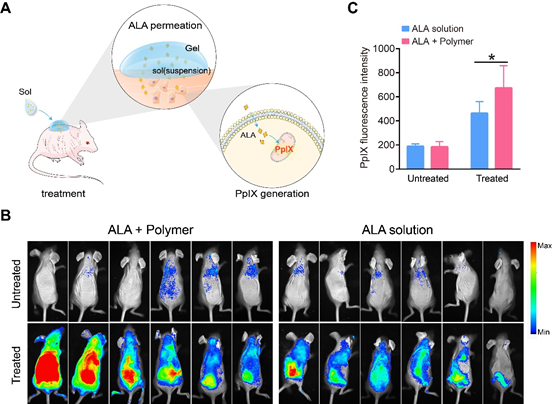 +565 975 658
+565 975 658
 info@premiumcoding.com
info@premiumcoding.com
 Monday - Friday, 8.00 - 20.00
Monday - Friday, 8.00 - 20.00
The thermogels made of block copolymers of poly(ethylene glycol) (PEG) and poly(D, L-lactide-co-glycolide) (PLGA) have been widely investigated in drug delivery fields owing to its physical gelation upon heating. The aqueous PEG/PLGA copolymer systems can exhibit two phase transitions: sol-gel transition and gel-precipitate or gel-sol(suspension) transition. While biomedical formulations developed for various applications have been based on the first transition (sol-gel transition), the second transition (gel-sol(suspension)) has not yet been taken into consideration.
Ding’s group at Fudan University reports, for the first time, a case employing both the sol-gel transition and the gel-sol(suspension) transition, which was found in their development of a transdermal hydrogel formulation. The transition temperatures of the formulation can be adjusted to meet the condition of sol-gel transition temperature (Tgel) < room temperature (Tair) < gel-sol(suspension) temperature (Tsol(suspension)) < body temperature (Tbody). Therefore, after applying to a skin, formulation of spontaneous asymmetry with a hydrogel outside and a sol(suspension) inside could avoid free flowing and achieve rapid release to ensure an efficient photodynamic therapy (PDT).
5-aminolevulinic acid (ALA) is a photosensitizer used in PDT. Shanghai Fudan-Zhangjiang Bio-Pharmaceutical Co., Ltd has developed ALA hydrochloride salt into market as clinical treatments of various skin diseases. The ALA solutions, which are widely applied in clinics, are easy to flow and then cause loss of drug. The ALA cream formulation may be hard to match the desired rapid release of ALA during 3 hours of administration for the forthcoming PDT. Therefore, a formulation that can avoid free flowing and realize rapid release for ALA is much required.
The principle of such an intelligent formulation with spontaneous asymmetry is presented in Figure 1.

Figure 1. Schematic presentation of the basic idea of the thermogel formulation with spontaneous asymmetry.
Then the facile adjustment of the two state transition temperatures gets to be the key to the corresponding biomaterial, since the traditional adjustment method of changing molecular wight of polymers is expensive and complicated. To this end, Ding’s group employed the “block blend” strategy put forward previously by their own group, in which two PEG/PLGA block copolymers were mixed to generate a thermogel system with highly tunable transition temperatures. One of the amphiphilic copolymers was relatively hydrophilic (copolymer-1), the other was relatively hydrophobic (copolymer-2). Each of them cannot exhibit sol-gel-precipitate transitions in water with temperature changing, but the appropriate blends can, and the transition temperatures could be well tuned, as shown in Figure 2.

Figure 2. The “block blend” strategy of blending two copolymers adjusts transition temperatures.
The biocompatibilty and efficacy of the new polymeric biomaterial and also the new type of drug foumulationm have been further confirmed. Some data about effectiveness is shown in Figure 3.

Figure 3. In vivo experiment to demonstrate the efficacy of the transdermal delivery of the ALA loaded hydrogel formulation.
This work was published in Advanced Functional Materials with two graduates Ms. Dinglingge CAO and Ms. Xi CHEN as the co-first-authors. See please: Dinglingge Cao#, Xi Chen#, Feng Cao, Wen Guo, Jingyu Tang, Caiyun Cai, Shuquan Cui, Xiaowei Yang, Lin Yu1, Yong Su, Jiandong Ding*, An Intelligent Transdermal Formulation of ALA Loaded Copolymer Thermogel with Spontaneous Asymmetry by Using Temperature Induced Sol-Gel Transition and Gel-Sol(Suspension) Transition on Different Sides, Advanced Functional Materials, 31(22), 2100349 (2021)
Article links: https://doi.org/10.1002/adfm.202100349
Get to know us better now!

Wechat:FDUMMers
Search!
Search across our website
Revenant @ 2018 by fudan | All Rights Reserved
Powered by Weicheng

